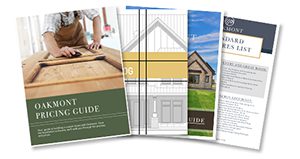Building a custom home on your own land is a fantastic decision. It allows you to create a home that perfectly suits your tastes and needs on the perfect lot.
The budget, suitability of the lot for the project, choice of builders, and several other factors may impact the success of your project without proper planning and execution. If your question is, “how to build a home on my land,” we’ve got the answer for you.
This guide walks you through the essential steps and considerations when building on your own land.
Setting A Budget

The cost of building a house on your own land adds up quickly. Setting a budget helps you manage your finances. When you decide on a budget, you can avoid financial stress, monitor and control your construction costs, and make the best decisions for your new home.
Determine Your Financial Capacity
First, determine exactly how much you can spend. Building a custom home is a huge responsibility, and 78% of homebuilders will consider financing options to reduce their financial stress when building a house on their own land. Before considering these financing options, ask yourself – “can I pay the down payment and monthly mortgage payments?”
Consider your monthly income and debts to determine the monthly mortgage payments you can afford. Also, get in touch with a lender early. They will conduct a more detailed evaluation and provide you with an estimate of the total amount you can borrow based on your financial situation.
Research How Much It Costs to Build a House on Your Own Land
Get an idea of your potential costs by researching the real estate market where your lot is and speaking with local builders. The national average for new home construction in 2022 was $252 per square foot, but the prices vary depending on location, finishes, and quality. For example, as a Boise custom home builder, our average varied from the national average, so beginning a conversation with your local builders can help highlight the differences in cost and expectations.
After determining the cost per square foot, the next step is to factor in the price of developing land. Suppose your lot has no utility connections, you may incur expenses like installation fees and trenching.
Plan For Unforeseen Costs
Unforeseen costs place significant financial strain on your project if you don’t prepare for them.
The prices of construction materials fluctuate, structural issues requiring immediate attention may arise, and weather-related delays may extend the project timeline, leading to increased labor costs.
A general rule of thumb is to set aside 10-20% of the total project cost as contingency funds for when unexpected expenses arise during the construction.
Assessing the State of The Land

Building a house on your own land won’t be possible without assessing the state of the land. You may have a weak or unstable foundation or drainage problems. Custom home builders and contractors can only build on your land if deemed suitable.
Fortunately, you can mitigate these risks and ensure a safer, more cost-effective, and more enjoyable home-building experience by hiring a surveyor. They provide you with a detailed legal description of your lot. Most professional building companies can provide a surveyor to ease the process. A land assessment typically involves:
- Evaluate the Soil Quality – The land surveyor’s team performs soil tests to ensure soil quality does not affect your project. This test determines the composition, stability, and soil load-bearing capacity to identify if there is any issue with the soil that may affect your home’s foundation. It will also determine if the soil has proper drainage capability to prevent water accumulation.
- Check for Zoning Status and Restrictions – The surveyor will determine your land’s flood zone status. They consult flood zone maps and historical data to evaluate your home’s risk of flooding. They will also assess the restrictions and building codes in your jurisdiction, ensuring the home you design is compliant
- Determine the Grade/Slope of the Land – Where your lot is situated affects the floor plan design and house placement. For instance, lots on steep slopes may require additional engineering or retaining walls. Evaluate the slope of the land to determine which area needs improvement and how to plan the home design.
- Check if the Land Needs Improvement – Many obstacles weaken your home’s foundation. Inspect the lot for potential challenges before you proceed with the other stages of your home-building journey.
Finding A Custom Builder

A custom home builder makes the home-building process easier. With a custom builder, you can expect attention to detail, superior construction techniques, and a focus on delivering a home that exceeds your expectations regarding durability, functionality, and aesthetics.
You also have the opportunity to be actively involved in the decision-making process, from creating a custom floor plan to choosing finishes and materials.
The builder’s professional team, including their architects, designers, surveyors, and project managers, will guide you through each step, ensuring the results meet your taste. So, how do you find a reliable custom home builder?
Research and Select at Least Three Reliable Local Builders Near You
First, you need to find at least three different builders you trust to do a job you will love.
Make a list of potential custom home builders by searching online directories or asking friends and family for recommendations.
Verify Their Portfolio, Expertise, and Experience and Ensure They Have A Reliable Team
Once you have a shortlist of potential builders, it’s time to make sure they can build the home of your dreams.
Ensure the builders you select fit your project, ask for testimonials or consult with Google and Facebook reviews. Talk to the builder and verify they have a well-rounded team of professionals, including architects, designers, surveyors, and other necessary industry experts.
A tour of a model home or recently completed home gives you a general idea of their craftsmanship and attention to detail.
Sign a Contract with the Builder
After evaluating the builders on your list, select one and sign a formal construction agreement.
Depending on the custom home builders you choose, the specific details of your construction contract may vary. For instance, if you are considering custom home builders to build your custom home and want to assess their financing options, you should know the pre-construction deposit, the quoted price for the building of your custom home, and the different financing options available.
Collaborate With Builder on the Design and Floor Plan
True custom home builders will provide a draftsman or architect to design a custom floor plan that suits their customer’s needs. This way, your home is exactly what you need, from foundation to finish.
Developing the Land

Most lots won’t require this step because they have already undergone this development, and people often buy lots from developers that are ready for construction. Land preparation is vital when building on your own land if necessary. It ensures the construction process is smooth and helps minimize potential risks.
If your lot needs development, you can hire a developer to do the job for you or ask your builder to contract a developer for you. Here’s what proper land preparation entails.
- Remove Trees, Vegetation, and Debris on the Lot – Before you build on your own lot, you must ensure nothing obstructs the process. For instance, trees, shrubs, debris, rocks, old structures, discarded materials, and vegetation litter the lot and take up space, making it challenging to start laying the foundation. Collaborate with your builders to clear the land of these obstructions.
- Level the Land – Grading work helps you shape your land to prevent flood risks and poor drainage and ensure proper home placement. Development teams include land surveyors and civil engineers who plan how to level the ground to minimize these risks.
- Install Utilities Like Water, Electricity, Sewage, and Drainage Systems – Construction work won’t run smoothly without essential utilities like water, electricity, sewage, and drainage systems. A developer installs these fixtures, plans the electrical layout, and determines your home’s best sewage and drainage solutions.
Begin Construction

You’ve taken all the necessary steps to build on your own lot; now it’s time to start the project construction. Here are some steps to help you out.
Determine the Timeline for the Construction
Collaborate with the builder to set a realistic timeline and schedule for your construction project. Builders will often consider the size and complexity of the project, the availability of resources, and any potential external factors that may affect the timeline, such as weather conditions or permit approvals, to determine the construction timeline.
After this, the builders can start building your home. They typically:
- Break the ground and pour the foundation according to the desired floor plan.
- Schedule construction walkthroughs to monitor progress and ensure compliance with your requirements.
- Frame the building structure and erect the walls of the house.
- Guide you through custom selections to personalize your home and reflect your unique style.
- Install interior and exterior finishes from roofing to plumbing, flooring, cabinets, countertops, bathroom fixtures, and electrical systems based on your preferences to complete the home design.
Enjoy Your New Home!
Building on your own land is a memorable milestone. It makes you feel pride and accomplishment as you walk through the rooms you meticulously designed, admires the finishes that reflect your personality, and relish in the comfort and functionality of your space.
The process can seem challenging from start to finish, but working with reliable builders will help you build that sanctuary that embodies your dreams.
As you consider building a house on your own land, we hope this guide will help you make informed decisions to see your dream home become a reality.





